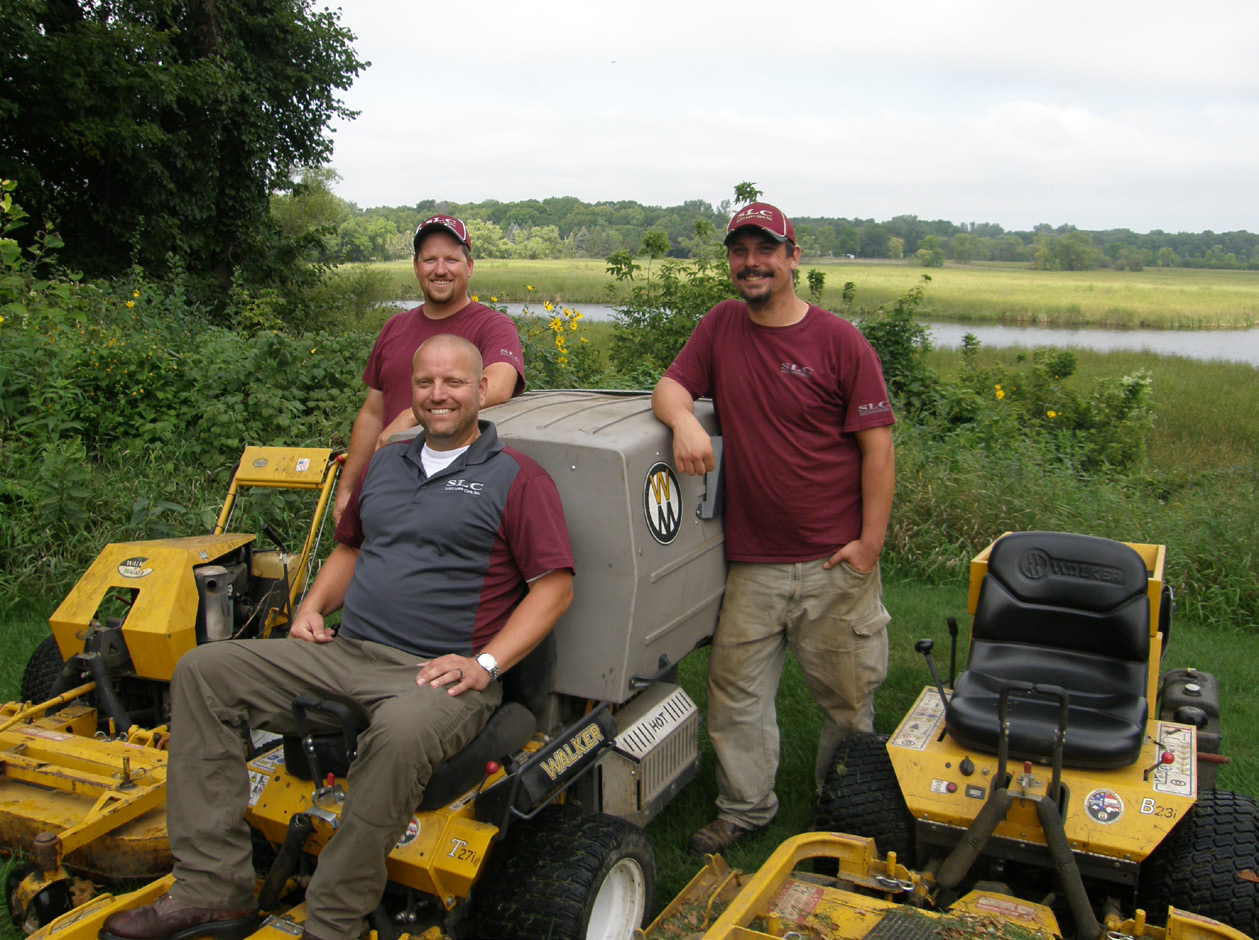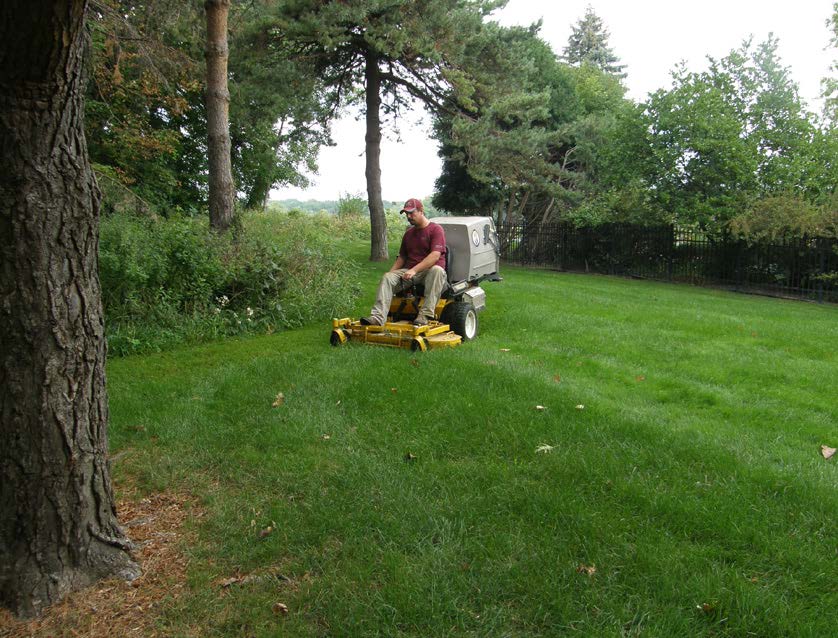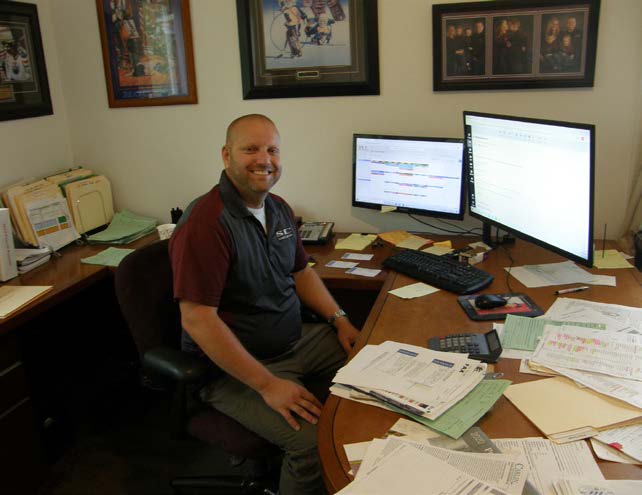
A typical Scott’s Lawn Care maintenance crew has three Walker Mowers, a walkbehind, GHS mower, and a Model B. Pictured here are l to r: operations manager Tony Melendez, owner Scott Hartmann, and assistant operations manager Allen Kasheimer.
Scott’s Lawn Care isn’t having the kind of growth year its owner anticipated, but still yearly sales goals are within sight. A miss would only mean being off by five to 10 percent. That says a lot for a company that lost several days of work right in the beginning of spring startup when the Minnesota governor declared the landscaping to be a nonessential industry. Fortunately, the decision lasted only two weeks before the governor reversed his decision.
“Those first couple weeks of the shutdown caused by the pandemic were difficult and kind of caught us off guard,” said company president, Scott Hartmann. “We worked through it and, as the season wore on, we adjusted as did most of our customers.”
Internally, he noted COVID-19’s biggest impact has been felt on the company’s inability to hold large company-wide meetings, although smaller divisional get-togethers keep the communication and training ongoing. Crews did not have to be downsized to accommodate social distancing because the maintenance division already ran two-man crews.
He explained that maintenance revenue for both commercial and residential customers has remained steady this year. Enhancement add-on sales are down on the commercial side but have experienced an uptick for residential customers who are spending more time at home, telling Hartmann, “I’m home, so let’s get it done.”
Located in Maple Plain, Minnesota., just west of the Twin Cities, Scott’s Lawn Care has been in business since 1998. The company employs 27 people (a number that expands to 37 during snow removal season) in four divisions: maintenance, fertilizing, snow removal, and TLC or landscape renovation. The company sits on a 20-acre property with plenty of room for a tree farm, mulching operation, and accommodating a testing site for a new venture, a robotic mowing service.
EARLY START
Like so many successful landscape contractors, Hartmann was introduced to the industry at an early age. As a 12-year-old, he was already mowing neighbors’ lawns, and by 16, he had enough work to buy a used 36-inch Snapper walk-behind mower. Before his high school graduation, Hartmann had already purchased a small fertilizing company, and a few years later he added a commercial company to his list of acquisitions.
Along the way he took several classes at two area technical colleges to receive turf establishment and management training, certification as an Outdoor Power Technician, and a Briggs & Stratton Master Certified Technician.
“Looking back, I could have avoided some mistakes by working for another landscape contractor before going on my own,” Hartmann said. “On the other hand, lessons learned the hard way have a tendency to stick with you.”
Knowing what equipment works best for the application is one area where experience can shorten the learning curve, he added, using as an example his introduction to the Walker Mower.
“I was doing a lot of bagging and was always looking for ways to make it more efficient. While visiting my dealer, I noticed a different bagging system on a mower, and when asked about it, the salesperson told me the design was based on a Walker Mower. I had never seen nor heard of a Walker. Later that summer, at the GIE+EXPO in Louisville, I kept hearing the same comment that ‘this bagging unit is based on the Walker design.’ So, I decided to see for myself. I went to the Walker Mower booth, saw the mower, and within two weeks I had one of my own.”

Despite Covid-19, maintenance revenue for both commercial and residential customers has remained steady this year.
Twenty-two years later, he still uses that mower, an MT 20, as a backup during leaf collection. Today, Scott’s Lawn Care has more than 20 Walker Mowers (some as backup units), and each maintenance crew is equipped with three of them: a Model MT 25 with a GHS deck, a Model B with a 52-inch side discharge deck, and a bit of history, a Walker Mower walk-behind unit with a 56-inch side discharge deck.
“Our maintenance accounts are divided almost equally between commercial and residential properties. We have five two-man crews, and depending on the property, different mowers are employed,” Hartmann explained. “They use the GHS decks for mowing around swimming pools, garden beds, and any other high-profile areas where clippings need to be picked up. The Model B is for larger areas, and the Walker walk-behind for hilly terrain.”
Scott’s Lawn Care buys three or four new Walker Mowers every year, some to replace existing units and others to accommodate growth. Since the Walker walk-behind has not been on the market for several years, Hartmann says he can’t buy a new one, but what he can do is buy used ones for their parts.
All five crews employ box trucks that come in especially handy for handling debris. Clippings and leaves are transported back to base where they are later mulched and used by the TLC crews.
MAINTENANCE AND BEYOND
Maintenance accounts for 40 percent of Scott’s Lawn Care’s revenue. The fertilizing division, including aeration along with weed and pest control, brings in 15 percent. This division also offers structural pest control, something a bit unusual for landscape contractors.
The TLC service adds another five to 10 percent in sales. Despite being offered exclusively to current customers, it is still positioned to be the biggest growth area. Snow removal for primarily commercial clients makes up the rest.
The Twin Cities area averages around 50 inches of snow a year, which translates into 14 plow events and 20 “nuisance events” for Scott’s Lawn Care. Approximately 60 percent of the company’s commercial customers are on a per push arrangement for snow; the rest are on a seasonal contract. “There’s no question that budgeting snow is a challenge. Even in Minneapolis where one thinks it snows all winter long, it doesn’t. To be safe, we budget for a less than normal snow year,” said Hartmann.
The tree farm is a luxury that most landscape contractors do not have, as is the space for composting lawn debris or testing a piece of equipment like a robotic mower. This is Scott’s Lawn Care’s second season with the robot mowers, and it currently has Husqvarna mowers on 12 sites, nine commercial properties and three residences. Currently, the thought is to place them on larger areas where they don’t have a lot of obstacles to overcome and where they can either save man-hours or allow crews time to provide additional services.
LESSONS LEARNED
Even though Hartmann indicated he enjoyed landscaping more than maintenance when he first started his company, he learned quickly that maintenance was ongoing. It is no surprise then that the company’s Walker Mowers and its five Ventrac tractors are the company’s highest revenue-generating pieces of equipment.
“I immediately fell in love with the Walker Mowers and how the GHS decks handle the lush Kentucky Bluegrass,” he related. “The deck variety and the introduction of the Model B give crews even more versatility. Ventrac, with its myriad of attachments, comes in a close second, when it comes to generating dollars.”
As the company grew, Hartmann learned how important a good company culture is for an industry that can be labor challenged.
“I call our culture one that is family-oriented. We employ our full-time people year-round, encourage teamwork and having fun, offer bonuses and other incentives, and post customer compliments,” he added. “Having a positive attitude is first and foremost among qualities we look for in new hires, because there will be challenges and days when things don’t go well.”

Scott Hartmann enjoys being in the field with his crews, but balances that by spending time working on his business and focusing on topics like job-costing.
Another important lesson? Learn from others. Scott’s Lawn Care has been a member of an industry peer group for the last seven years. Throughout the year, participants travel to a fellow member’s facility and share best practices. Scott’s Lawn Care has hosted two such meetings with the owner, among other things, sharing his thoughts on job-costing. “I’ve always been focused on job-costing,” said Hartmann. “We have manager meetings every Tuesday morning where we track man-hours, actual hours, and overtime. We also hold monthly budget meetings. I was a CLIP software user early on to help with job-costing and more recently have switched to Service Auto Pilot.”
When asked about an issue with which the group has helped him, he replied, “Getting out of my own way. I still think it’s important to be with crews and show employees you would do anything that you ask them to do.” But as he pointed out, the old saying, “you have to learn to work on and not in the business,” still makes sense.
Hartmann has plenty of people to help him along the way, including operations manager Tony Melendez, assistant operations manager Allen Kasheimer, accounts manager J.D. Stavlo, and office manager Teri Johnson. His wife Jackie handles accounts payable/receivable and his father Terry, a former developer, helps with sales.
When not working in or on the business, Hartman and his wife enjoy spending time with their three children, 11-year-old twins Joe and Lucy and 5-year-old son Mack. Hartmann also is a lieutenant and EMT for the Maple Plain Fire Department.





 Site Search
Site Search



